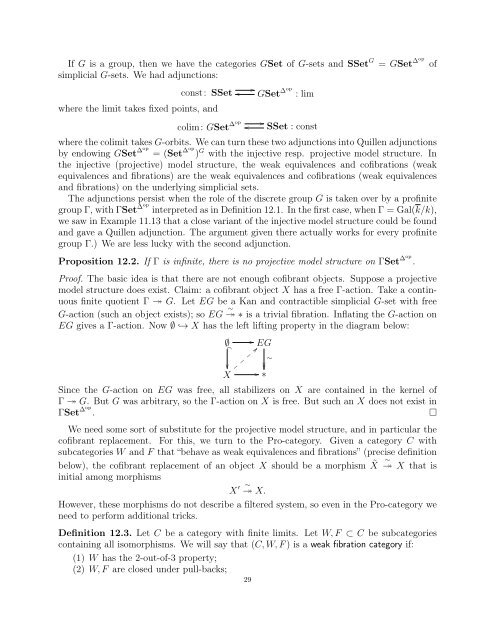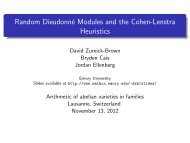alternative lecture notes - Rational points and algebraic cycles
alternative lecture notes - Rational points and algebraic cycles
alternative lecture notes - Rational points and algebraic cycles
You also want an ePaper? Increase the reach of your titles
YUMPU automatically turns print PDFs into web optimized ePapers that Google loves.
If G is a group, then we have the categories GSet of G-sets <strong>and</strong> SSet G = GSet ∆op<br />
of<br />
simplicial G-sets. We had adjunctions:<br />
const: SSet<br />
where the limit takes fixed <strong>points</strong>, <strong>and</strong><br />
GSet ∆op : lim<br />
colim: GSet ∆op SSet : const<br />
where the colimit takes G-orbits. We can turn these two adjunctions into Quillen adjunctions<br />
by endowing GSet ∆op<br />
= (Set ∆op ) G with the injective resp. projective model structure. In<br />
the injective (projective) model structure, the weak equivalences <strong>and</strong> cofibrations (weak<br />
equivalences <strong>and</strong> fibrations) are the weak equivalences <strong>and</strong> cofibrations (weak equivalences<br />
<strong>and</strong> fibrations) on the underlying simplicial sets.<br />
The adjunctions persist when the role of the discrete group G is taken over by a profinite<br />
group Γ, with ΓSet ∆op interpreted as in Definition 12.1. In the first case, when Γ = Gal(k/k),<br />
we saw in Example 11.13 that a close variant of the injective model structure could be found<br />
<strong>and</strong> gave a Quillen adjunction. The argument given there actually works for every profinite<br />
group Γ.) We are less lucky with the second adjunction.<br />
Proposition 12.2. If Γ is infinite, there is no projective model structure on ΓSet ∆op .<br />
Proof. The basic idea is that there are not enough cofibrant objects. Suppose a projective<br />
model structure does exist. Claim: a cofibrant object X has a free Γ-action. Take a continuous<br />
finite quotient Γ ↠ G. Let EG be a Kan <strong>and</strong> contractible simplicial G-set with free<br />
G-action (such an object exists); so EG ∼ ↠ ∗ is a trivial fibration. Inflating the G-action on<br />
EG gives a Γ-action. Now ∅ ↩→ X has the left lifting property in the diagram below:<br />
∅ EG<br />
<br />
<br />
∼<br />
<br />
X ∗<br />
Since the G-action on EG was free, all stabilizers on X are contained in the kernel of<br />
Γ ↠ G. But G was arbitrary, so the Γ-action on X is free. But such an X does not exist in<br />
ΓSet ∆op .<br />
□<br />
We need some sort of substitute for the projective model structure, <strong>and</strong> in particular the<br />
cofibrant replacement. For this, we turn to the Pro-category. Given a category C with<br />
subcategories W <strong>and</strong> F that “behave as weak equivalences <strong>and</strong> fibrations” (precise definition<br />
below), the cofibrant replacement of an object X should be a morphism ˜X ∼ ↠ X that is<br />
initial among morphisms<br />
X ′ ∼<br />
↠ X.<br />
However, these morphisms do not describe a filtered system, so even in the Pro-category we<br />
need to perform additional tricks.<br />
Definition 12.3. Let C be a category with finite limits. Let W, F ⊂ C be subcategories<br />
containing all isomorphisms. We will say that (C, W, F ) is a weak fibration category if:<br />
(1) W has the 2-out-of-3 property;<br />
(2) W, F are closed under pull-backs;<br />
29



